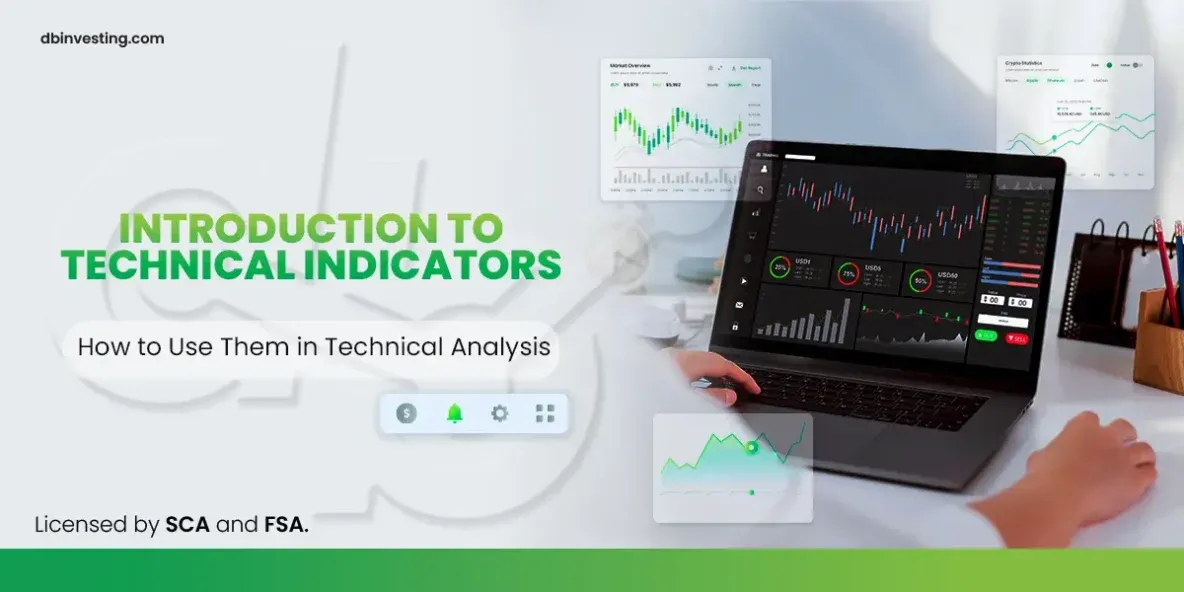What are Technical Indicators?
Technical indicators are essential tools in technical analysis used to help traders make informed trading decisions. When combined with appropriate risk management tools, these indicators allow traders to assess price trends and predict movements in financial markets in the short term. Technical indicators are mathematical calculations based on price data and trading volume, used to identify trends and patterns in price movements. These indicators can show the direction a financial asset is moving during a specific period, helping traders identify the best trading opportunities.
At DB Investing, our platform provides traders with access to a wide range of technical indicators, empowering you to make well-informed decisions and take control of your trading strategy.
Types of Technical Indicators
There are two main types of technical indicators:
- Leading Indicators: These indicators provide signals before the initial price movement, helping traders predict future changes.
- Lagging Indicators: These indicators provide signals after the initial movement and are used to confirm the current trend.
Commonly Used Technical Indicators
1. Moving Average (MA)
The Moving Average is one of the most common lagging technical indicators used to determine the current price trend in the market. It averages the price points of a financial instrument over a specified time frame (such as 15, 20, 30, 50, 100, or 200 periods) and divides them by the number of data points to give a single trend line. The moving average helps confirm the current trend and reduces the effect of random price fluctuations. In most cases, when prices move above the moving average, the current trend is considered upward, while when prices move below the moving average, the current trend is considered downward.
There are many different types of moving averages, and some traders use more than one to confirm their signals. This includes simple moving averages and exponential moving averages (which give more weight to recent data).
2. Exponential Moving Average (EMA)
The Exponential Moving Average is an improved version of the Simple Moving Average (SMA) that gives more weight to the most recent price data, making it more responsive to recent market changes. It is placed as a line on the price chart based on a mathematical formula to smooth out price movements. By assigning more weight to the recent price and less to past prices, the EMA reacts more quickly to recent price changes compared to the simple moving average, which applies equal weight to all movements during the
period. To use the EMA, simply go to our MT4 platform and select the Exponential Moving
Average from the indicator list. You can also adjust the number of periods to be
calculated. Commonly used periods for long-term price tracking are 50, 100, and 200,
while 12, 26, and 55 periods are often used for shorter timeframes.
3. Moving Average Convergence Divergence (MACD)
The Moving Average Convergence Divergence (MACD) is a momentum trend-following indicator that shows the relationship between two moving averages of an asset’s price. The MACD is calculated by subtracting the 26-period EMA from the 12-period EMA.
MACD = 12-period EMA – 26-period EMA
The result of this calculation is the MACD line. The nine-day EMA of the MACD is called the “signal line.” It is drawn above the MACD line, serving as a trigger for buy and sell signals. Traders may buy the asset when the MACD crosses above the signal line and sell when the MACD crosses below the signal line. MACD signals can be interpreted in various ways, but the most common methods are crossovers, divergences, and overbought/oversold conditions.
4. Relative Strength Index (RSI)
The Relative Strength Index (RSI) is a momentum indicator used to evaluate overbought or oversold conditions in the price of an asset. The RSI is displayed as an oscillator that moves between 0 and 100. Values above 70 are considered an indication that the asset is overbought and may be due for a trend reversal, while values below 30 indicate that the asset is oversold and may be undervalued. These levels are known as overbought and oversold lines.
The RSI shows a potential buy signal when the RSI crosses above the oversold line (30). A potential sell signal occurs when the RSI crosses below the overbought line (70).
With DB Investing’s tools, you can seamlessly integrate the RSI indicator into your analysis to identify market conditions and make well-timed trades.
How Are Technical Indicators Used in Trading?
Technical indicators can be used in various ways to enhance trading strategies:
- Confirming the Trend: The Moving Average and Exponential Moving Average help confirm the current market trend.
- Identifying Momentum: The MACD and RSI help identify the strength of momentum and potential reversal signals.
- Crossovers: Moving average crossovers and signal line crossovers in the MACD are used to generate buy and sell signals.
Conclusion
Technical indicators are powerful tools that assist traders in analyzing markets and making informed trading decisions. By understanding how these indicators work and how to apply them correctly, traders can improve their strategies and achieve better results in financial markets.
At DB Investing, we offer educational webinars and training courses covering the most important strategies used in financial analysis. You can register for them by clicking here.
Blog – DB Investing – Dream Big Investing FSA and SCA regulated

 Institutional Site
Institutional Site 